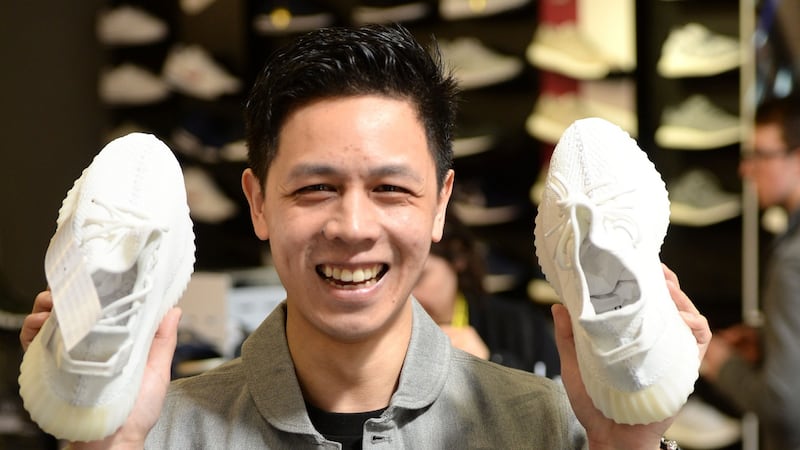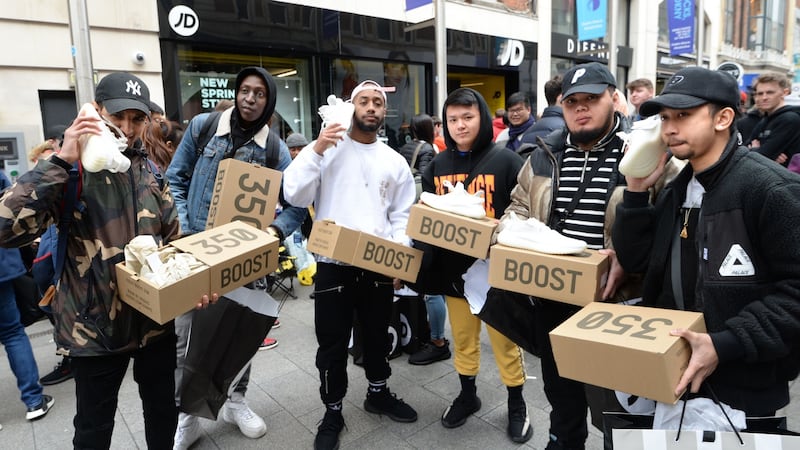When Kayne West's Yeezy Boost 350 V2 in "Cream White" (that's a runner to you and me) was released in Ireland last month, you couldn't just walk into a shop and buy a pair.
No, instead, the three shops selling the shoes (JD Sports, Brown Thomas and Size) ran a raffle system, meaning that if your name was drawn, you had an opportunity to buy the shoes.
This practice has been taking place in Ireland since the arrival of West’s shoes in June 2015. While some argue it’s a step in the right direction, ending the practice of queuing outside shops overnight, it does mean fans are forced to jump through one more hoop to be given the “opportunity” to spend a huge amount of money on a hyped-up pair of shoes.
One could argue that that’s worse than a cold night outside a shoe shop.
It doesn’t matter either way, because fans still queue up in the hope of grabbing any pairs of the €200-plus runners that aren’t collected by raffle winners. They rarely have much luck.
Fitness footwear fanatics, or “sneakerheads” as they are known, are a growing demographic willing to spend large amounts of time, energy and cold hard cash on sports style footwear.
Collaborated
Sneaker culture was born when RUN DMC collaborated with Adidas to release the RUN DMC Superstar in the 1980s. The now iconic shoe was the first big collaborative crossover between the worlds of rap and fashion.
Sneakerheads these days are mostly affluent young men and their obsession easily rivals the historic (and over-egged) female obsession with high heels and handbags.

Darren Rice, radio presenter and self-confessed sneakerhead, explains: "I own over 100 pairs. They're collectable, but I also actually wear mine. There are guys that wouldn't. There's an Irish guy, Peter Kendrick, who has 300 pairs. I'm pretty sure he doesn't wear any of them."
Actually, Kendrick (47) from Palmerstown in Dublin, tells us he does. "I own about 300 pairs and I wear about 95 per cent of them. I would very rarely wear the same pair in a six-month period, but that's just because I have so many.
“Some pairs I only wear on holidays, because they are really white, or certain pairs I’ll only wear in nightclubs, although that doesn’t happen much anymore,” he says with a laugh.
So where does Kendrick keep his 300-strong collection? “Most of them are up in the attic. There are also a good few in the spare room and there are about 30 in my son’s room under his bed, plus a few pairs in boxes around the house. Yeah, the Mrs goes mental every now and then.”
Simon Wai (31), another self-confessed sneakerhead, understands where Kendrick is coming from. "I've been collecting since I was about 17," he says. "I've about 35 pairs now but I used to have a lot more. I just had a baby and my sneaker room got turned into the baby room so I had to sell a lot. That hurt."
It’s only in the last 18 months that sneaker culture has begun to take shape in Ireland. “I’m 47 now,” Kendrick says, “but I started buying runners when I was about 17 and the scene has changed a lot since then.
Cultural influence
“The internet is what drives it. When I first started you had to go to London or Manchester to get what you wanted. I used to terrorise people I worked with who were heading abroad, giving them lists of runners.”
The arrival of Yeezy in Ireland changed all that. Yeezy Boost 350 sold out in minutes and yes, people camped outside the shops overnight. Limited edition “kicks” like Yeezys are what fuel sneakerheads.

Rice explains: “Kanye’s not an easy character to like but his cultural influence is insane. He wears a pair of socks one day, and the next the whole planet seems to want them. His global reach in terms of youth culture is staggering.”
Kendrick isn’t so keen. “I wouldn’t be caught up in the hype that goes on these days. The Yeezys are not for me though. Actually I think they’re awful looking. In 20 years’ time people won’t be chasing after them.”
He continues: “You have to ask yourself – what are you buying into? The aesthetic or the hype? With Yeezys, it’s only about the hype.”
Wai adds: “Before Yeezy, people wanted the sneakers that no one else had, but now everyone just wants the same thing. All the kids now are buying just to make a quick buck, the soul has gone out of it.”
Adidas has never said exactly how many pairs of Yeezy Boosts they’ve made available, but they are always limited. Demand always far outweighs supply and since the first release of only 9,000 pairs in December 2013, fans all over the world have gone to desperate lengths to get their hands on them.
In 2014, MTV quoted West as saying “I just wanna make sure that we keep it safe. I’ve heard about people getting hurt for sneaker culture in the past. I just want everyone to be safe and be patient.”
So who are the people going to such lengths? Rice says that a lot of “kids with well-off parents really seem to buy into it. Some of them even pay people to queue up for them. There is one kid I know who stood outside JD Sports on a Yeezy day and offered kids who had won in the raffle more than €200 over what they had just paid in store. He collected a fair few pairs that way.”
Fakes
Wai says: “I’m one of them. I was in the last Yeezy raffle. If I won I wouldn’t have worn them though.” Why? “Because everyone else would be wearing them and there are so many fakes. I’d be buying them to sell them on.”
It turns out it's more than just the love of the shoe that drives sneakerheads. Rice, who has made a short documentary on the phenomenon (watch it on irishtimes.com) explains: "It's hype – but it's also a business. I would say some 65 per cent are reselling and the rest are keeping them."
He goes on: “Yeezys are €180 in JD Sports. You could instantly resell them for €300 to €400. People put their names, their girlfriend’s names, their parent’s names and anyone else they can convince, into the raffles. If they’re lucky their names get drawn a few times. Then they make a bunch of money – all they have to do is persuade the girlfriends to go in and pick them up – only the named person can get them.”
The humble trainer has transcended the world of fitness and now belongs as much on the runway as it does on the treadmill
It could be worth it, as the resale value on a pair of Yeezys can be anywhere from double to 10 times the original price. Yeezy Boosts, which were released in Ireland in 2015 are, at the time of writing, available on eBay for €1,505. And a pair signed by Yeezus himself (that's Kanye to you and me) is on sale for just over €5,000.
On the same page, there’s another pair of Yeezys available for a much more affordable €7.
The seller of the more expensive pair has gone to great lengths to emphasise the authenticity, but as with any high-end garment, knock-offs flood the market. Chinese counterfeits claiming to be made in the same factories, with the same materials, pop up everywhere.
And it's not just Yeezys that go for huge sums of money. Reissues of classic or famous sneakers will inevitably carry hefty price tags. Rice says: "I've pairs that would resell for €3,000. The most I've sold a pair for is €6,500. They were the Nike Mags from Back to the Future Two.
Investment
“I paid €3,000 for them and held on to them for three years. They are the only pair I’ve owned and never worn, they were an investment. They weren’t the self-lacing Nike Mags though – some of those have sold for way more.” (A Hong Kong auction house sold a pair of self-lacing Nike Mags for $104,000 last year.)
Gone are the days of runners only belonging in the sport arena. The humble trainer has transcended the world of fitness and now belongs as much on the runway as it does on the treadmill.

And whether the Yeezy is considered hyped and ugly or the sneaker second coming, it has changed the fashion landscape in Ireland – and the world.
“Before the first Yeezys came out there was no scene. Yeezys have really brought a group of people together here. Since the first night we camped out in 2015, there were 20 odd people in the line and I still chat to those lads to this day,” explains Wai.
Cast your eyes down while walking any street and you’ll notice that many, if not most, feet are sneaker clad. Made with groundbreaking technology, with connections to sporting heroes or to musical heritage, the runner crosses many cultural borders.
This cross-genre appeal means an increase in price but also ensures the cultural currency of fitness footwear is evolving; making sneakers an investment for both your wardrobe and your bank account.

















